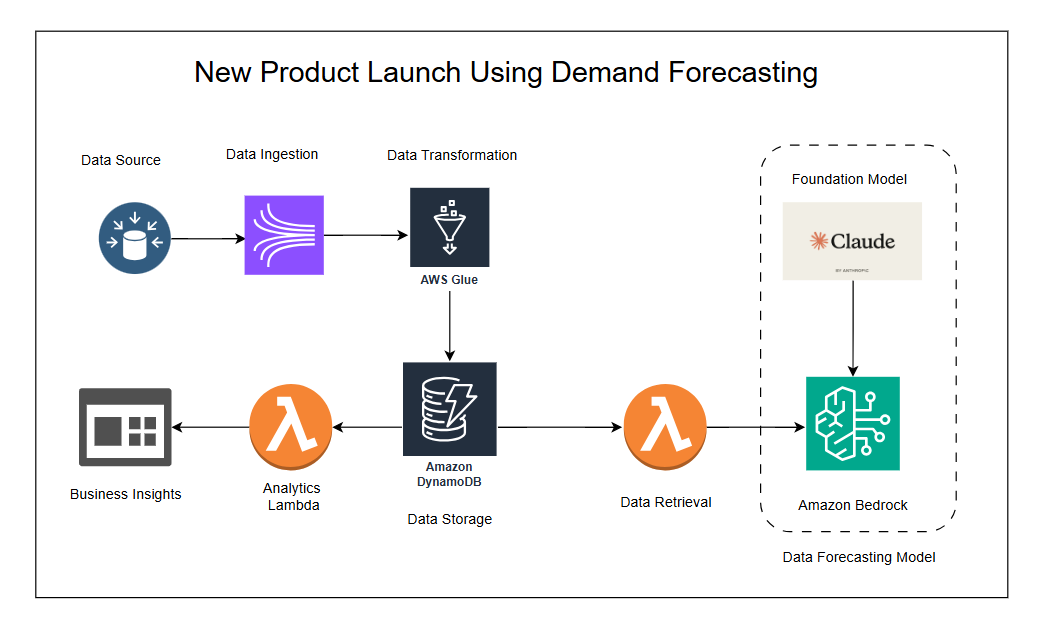
Leverage Technology for Advanced Demand Forecasting
Foundation of Our Approach
Anticipating customer's needs and demand planning accordingly, allows businesses to optimize operations, reduce costs, and improve customer satisfaction. In this use case, we will discuss how planning forecasting with accurate predictions helps optimize inventory and minimize costs.

New Product Launch Using Demand Forecasting
- Identify Target Market: Use historical data and market trends to pinpoint the most lucrative segments.
- Understand Competitor Landscape: Analyse competitors' products, pricing, and market positioning to identify gaps your product can fill.
- Leverage Historical Data: Use data from similar products or industry trends to predict demand.
- Use Predictive Analytics Tools: Employ machine learning algorithms to refine forecasts based on seasonality, economic indicators, and consumer behavior.
- Production Planning: Align production capacity with forecasted demand to avoid underproduction or overstocking.
- Inventory Management: Optimize supply chain logistics to ensure availability while minimizing carrying costs.
- Localized Campaigns: Adapt marketing messages to resonate with regional preferences and demand patterns.
- Targeted Advertising: Use data-driven insights to focus campaigns on demographics or geographies with the highest demand potential.
- Beta Testing: Gather real-time feedback by releasing the product to a select audience before the full-scale launch.
- Pre-Orders: Gauge consumer interest and validate demand by offering pre-order options.
- Adjust Strategies: Continuously monitor sales and market response to refine marketing and production strategies.
- Customer Feedback Loop: Use customer feedback to identify improvement opportunities and enhance product-market fit.
Accurate demand predictions allow businesses to allocate resources efficiently and avoid overproduction, leading to significant cost savings. Hence a data-driven approach to predicting demand for a new product launch is the most effective method.

The following outlines the components breakdown and processes involved in this initiative.
Detailed Breakdown of the Process
- Data Source:This represents the origin of the data used for demand forecasting. It could include various sources such as: historical sales data, market research data, social media trends, economic indicators.
- Data Ingestion: This stage involves extracting data from the source and preparing it for further processing. Tools like Kinesis or other data ingestion services can be used here.
- Data Transformation: This step focuses on cleaning, transforming, and enriching the data. AWS Glue, a serverless data integration service, can be used to perform tasks like data cleaning, normalization, and feature engineering.
- AWS DynamoDB: A NoSQL database that stores the transformed data efficiently for subsequent analysis.
- Analytics Lambda:Serverless compute functions that perform data analysis and aggregation on the stored data.
- Amazon Bedrock: A service that provides access to a wide range of foundation models, including Claude. These models can be used for various tasks like natural language processing, text generation, and in this case, demand forecasting.
- Data Retrieval: This stage involves retrieving the processed data from DynamoDB for use in the forecasting model.
- Data Forecasting Model: This is the core of the system. The foundation model (Claude) is leveraged to build and train a demand forecasting model. This model will use historical data and other relevant factors to predict future demand for the new product.
- Business Insights: The final output of the system. The demand forecasts generated by the model provide valuable insights for businesses, enabling them to: Optimize inventory levels, Plan production and marketing campaigns effectively, Make informed decisions about pricing and distribution.
Process Flow
- Data is collected from various sources.
- Data is ingested and transformed using AWS Glue.
- Transformed data is stored in Amazon DynamoDB.
- Analytics Lambda functions perform data analysis and aggregation.
- Data is retrieved from DynamoDB for model training.
- A demand forecasting model is built and trained using the foundation model (Claude) on Amazon Bedrock.
- The model generates demand forecasts for the new product.
- Business insights are extracted from the forecasts to inform decision making.
How Demand Forecasting Drives Business Grow
- Efficient resource allocation: Deploy infrastructure, and development resources more effectively by predicting future demand.
- Improved customer satisfaction: Proactively meeting customer's needs through demand forecasting ensures minimal disruption and reduced dissatisfaction.
- Better risk mitigation: Identifying potential spikes or lull in the market trends enables informed long-term business strategies and proactive measures to address challenges.
Leverage data forecasting models to make smart business decisions. Anticipate market trends and optimize operations. Connect with our experts to discover how predictive insights can boost your business strategy.